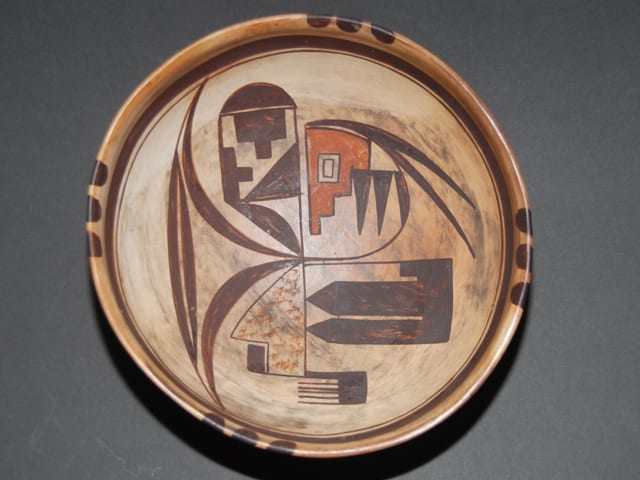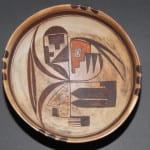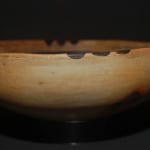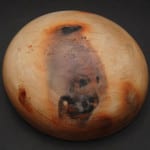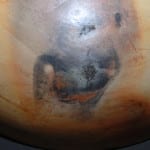This Hopi-Tewa bowl has an abstract geometric design, rim ticking, and an extra rim coil. The extra coil and cross-sectional shape suggests the bowl was formed by Nampeyo.
During a visit to his home (4/23/09), Ed Wade said he believed that Annie was the painter. Upon reflection, he attributes the bowl entirely to Nampeyo (see below). The form of the bowl is relatively deep with a modest but definite extra coil on the rim—a signature “Old Lady” trademark. The rim ticking indicates a production during approximately the first decade of the 20th century. (See the discussion of rim ticking with pot 2006-01.) The firing of the pot was imperfect; there are two clear burn marks on the bottom and a piece of fuel fused to the outside. In addition, the interior surface of the bowl is streaked with dark material that was probably not intended to be part of the design but may be the result of a firing mishap. Before the closing of the eBay auction, the seller, Mike Cardoza, noted someone has only partially cleaned the interior of this light blotchy, streaked pattern. The two framing lines—the thick top line and the lower thin line—are classic Nampeyo/Annie characteristics.
The design of pot 2006-11 is its most unique, intriguing and difficult characteristic. With few exceptions, the published photographs of Nampeyo and Annie pots show generally curvilinear designs that are derived from ancient Sikyatki ware. While the design of 2006-11 has some curvilinear elements, the overall design is composed of straight-line elements that are not generally characteristic of Nampeyo’s or Annie’s work. Kramer (1996:149) Plate 5 and perhaps plate 17 (Kramer, 1996:155) show similar straight-line designs. Although much more modest in its use of straight-line design, Figure 2.31-L in the Blairs’ book (1999-VI) seems to me closest in spirit to 2006-11. The Blairs write, “The design is reminiscent of the Payupki potters, who used straight-line elements.” Payupki is a Second Mesa village site that was settled by Rio Grande Tewa refugees who lived there between 1680 and 1745. According to the Blairs (1999:100), the ruins of this site were one of the sources of shards collected by Lesou that provided inspiration for Nampeyo and her eldest daughter. Kramer reaches a similar conclusion, noting that “shapes and designs borrowed from Sikyatki ware constituted only one of the many prehistoric periods incorporated” by Nampeyo (1996:160).
Nevertheless, the dominant use of straight-line elements in the design of 2006-11 is so unusual that it is difficult to fit this bowl into the body of Nampeyo’s or Annie’s work that is known to me. In his July 2009 appraisal, Ed Wade rejects any similarity to Payupki ceramics and places 2006-11 within a body of Nampeyo’s work he calls “Pure Abstraction.” (See Wade’s comments, below.) The design is built from a central point formed by the junction of two curved lines and horizontal and vertical lines—off which all the design elements are hung. Familiar Sikyatki Revival design devices are largely absent and the design challenges the viewer to see in new ways. Red, black, and stippled paint is used to fill in the forms. Some have seen the red element as a bird’s head with a clear eye and a feathered crest. Other feathered elements below the head might then be imagined as other various parts of a bird image. However, the design, perhaps, may best be seen as simply a collection of counter balanced elements that form a design. The image is reminiscent of a Paul Klee or perhaps a Max Ernst painting, though Nampeyo painted this bowl a quarter of a century before these “modern” artists. Indeed, it would be possible to recreate the design on 2006-11 with individual pieces of paper or metal and have a balanced mobile revolving around a curvilinear base.
In September 2010, two Nampeyo bowls were sold (by one seller) on eBay; they are remarkably similar to 2006-11. Both of these bowls have rim ticking, interior white slip and “purely abstract” designs. One has design elements especially close to the bowl in this collection.
The three bowls look like they were done by the same hand on the same day. The high prices paid for the September 2010 bowls suggest that the buyers had confidence that these two bowls are by Nampeyo. Perhaps they read this entry for 2006-11 on the internet. [Photos on file.]
For a jar with another “purely abstract” design, see 2003-10 in the collection.
Working from the website photos, in July 2009 Ed Wade concluded that 2006-11 is entirely a product of Nampeyo’s hand:
The artistic versatility of Nampeyo is well illustrated by the abstract composition of the bowl pictured above. This particular design fits comfortably within a style of composition that she perfected at the end of the 19th century. Unlike the motifs and layouts featured in her Sikyatki Revival wares, this “Pure Abstraction” has a kinetic and lyrical quality reminiscent of the geometric explorations of later Western artists the likes of Kandinski and Calder. One is reminded of the spontaneous erratic movement of a mobile spinning around a suspended thread. “Pure Abstraction” is also the most asymmetric of all Nampeyo compositions, ignoring framing lines and any units of serial repetition. In the layout pictured above she has built the design upon the framework of the traditional whirling log or swastika, common as interior filler in many of her later “Eagle Tail” designs. This distinctive style arose in the late 19th century and was first executed upon Polacca Polychrome vessels such as the Nampeyo jar and bowl pictured below. [picture removed]Unlike her Sikyatki Revival style in which compositions are built upon the incorporation of negative motifs, “Pure Abstraction” largely ignore this convention and rather floats the positive design upon the empty canvas of the vessel’s slipped surface.
There is a rare precedent for such designs within the Sikyatki tradition in which minimalist arabesque compositions stood out against the pearly white of the background clay.
To this Nampeyo added, as with the original bowl under discussion, Spanish-derived Polacca motifs such as the black-toothed comb-like element and elaborate fingered crooks. Seen at the top of this composition is a uniquely Nampeyo motif: a rectangle whose interior is filled with a black step pyramid to the side and top, which negatively defines a cubistic zigzag.
As for Blair’s assertion that the composition is similar to the Payupki tradition, I emphatically maintain that it is not. In my writings on Payupki ceramics I have detailed the alienness of their layouts, symmetry and color usage to Hopi aesthetics. Payupki was a Keresan settlement resulting from the aftermath of the Pueblo Revolt of 1680 and its ceramics; both sculpturally and compositionally, are affiliated with the pottery of Zia and Santa Ana.
–Edwin L. Wade

